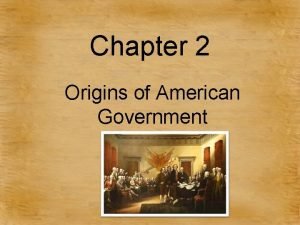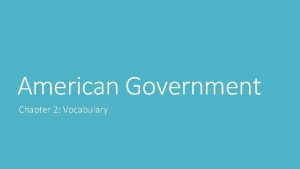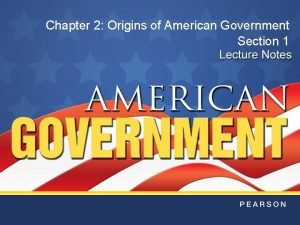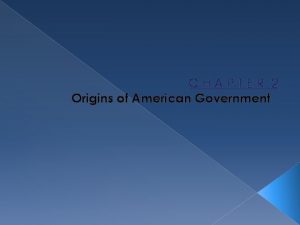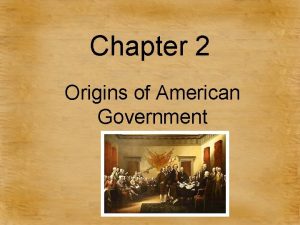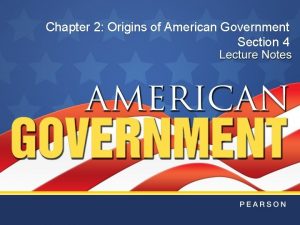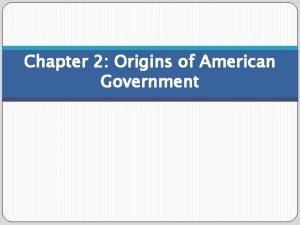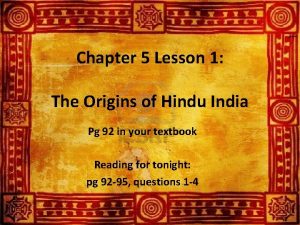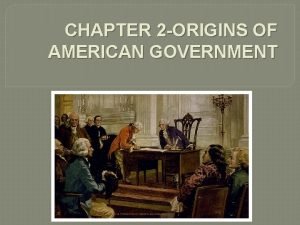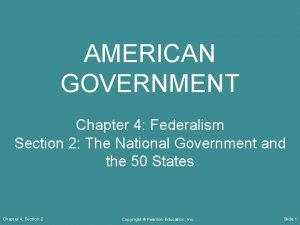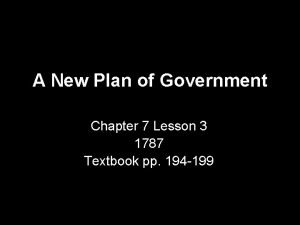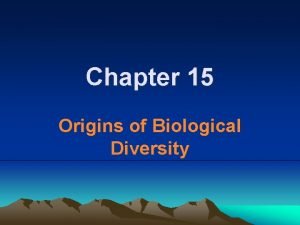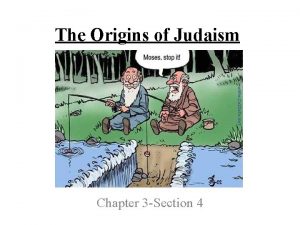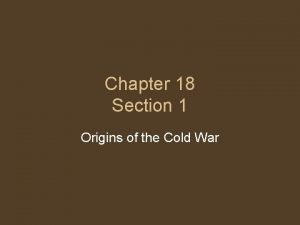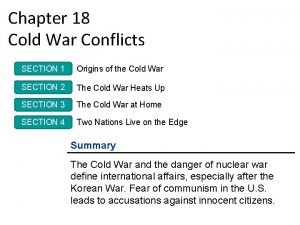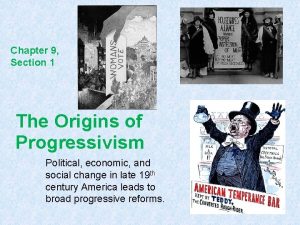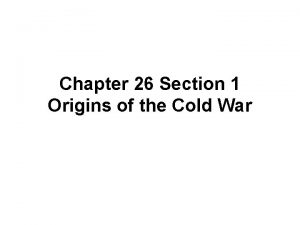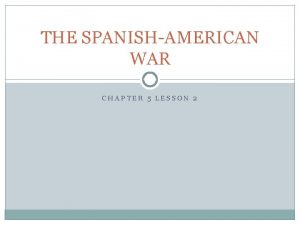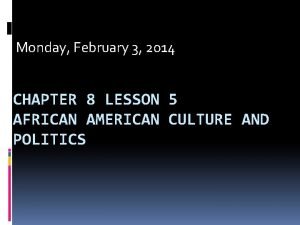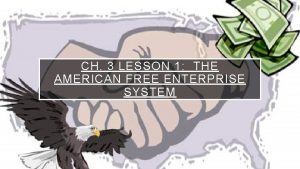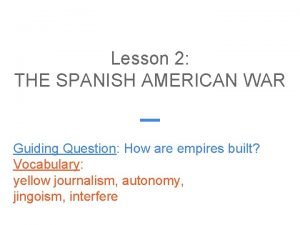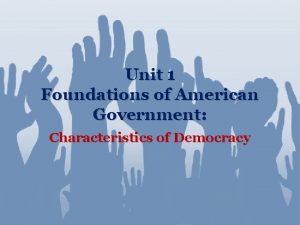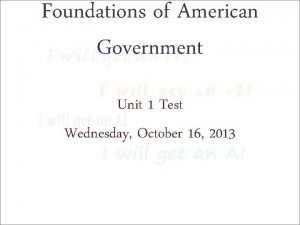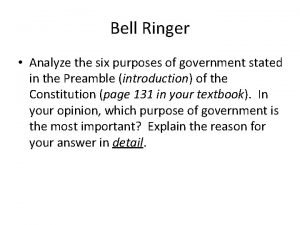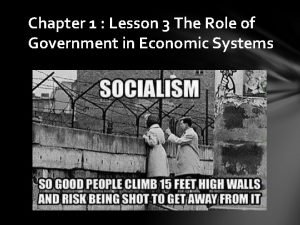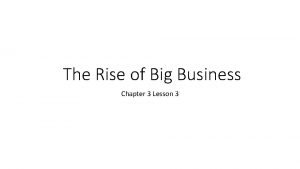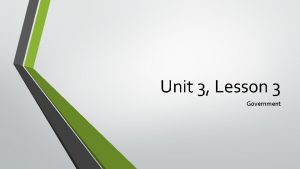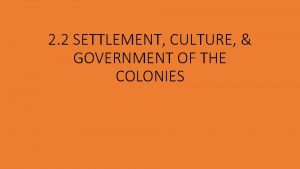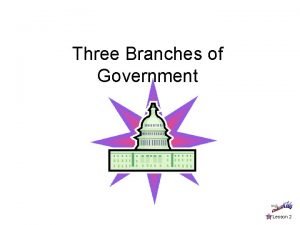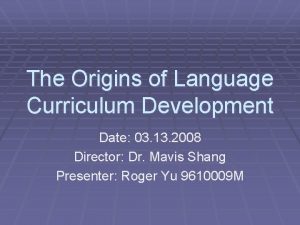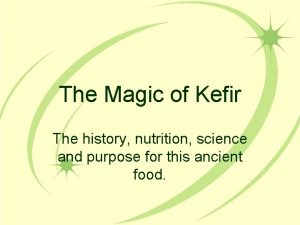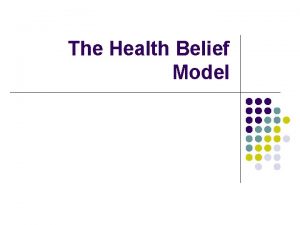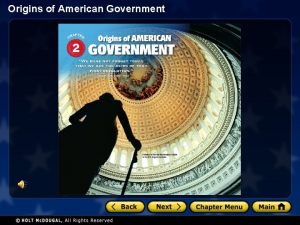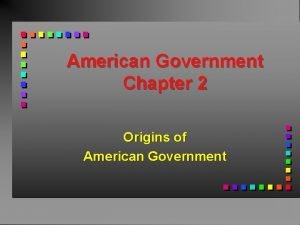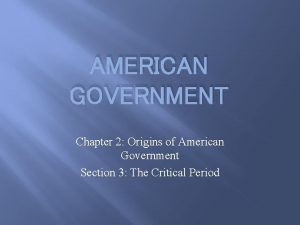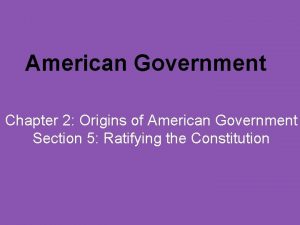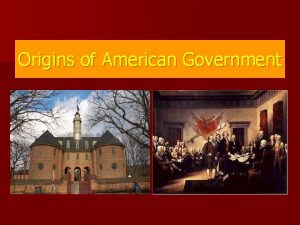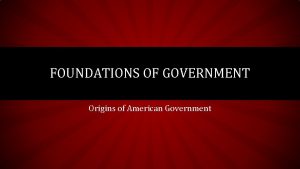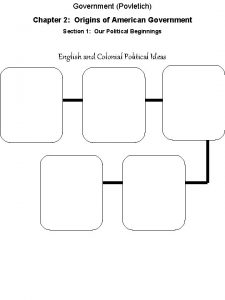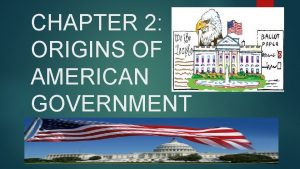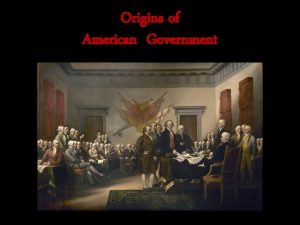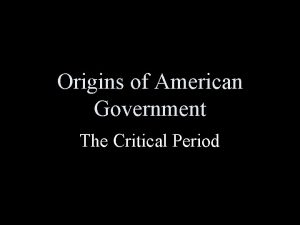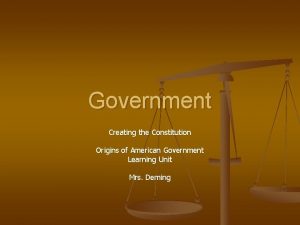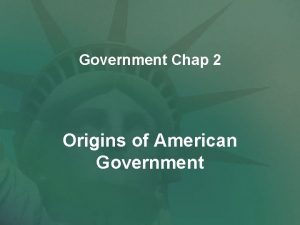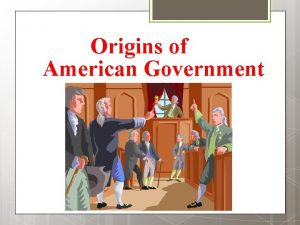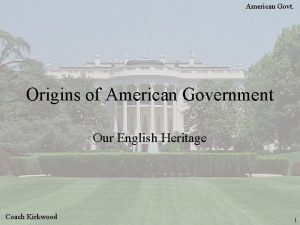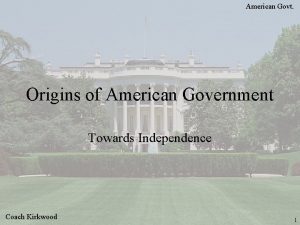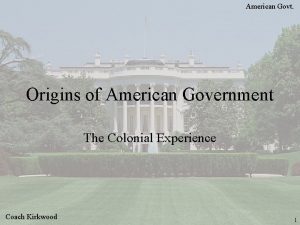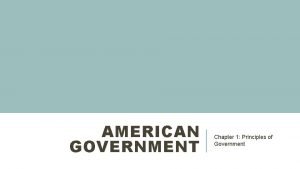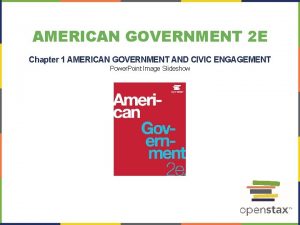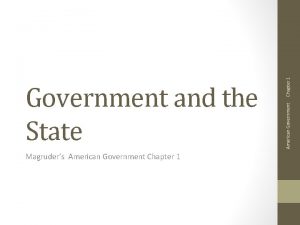Chapter 2 Origins of American Government Lesson 1












































- Slides: 44

Chapter 2 Origins of American Government

Lesson 1: Government in Colonial America • Essential Question: • What influenced the development of our government institutions?

English Colonist Brought Three Main Concepts: • The need for an ordered social system, or government. • The idea of limited government, that is, that government should not be all-powerful. Magna Carta • The concept of representative government—a government that serves the will of the people.

William and Mary of Great Britain

Three Types of Colonies in North America • The royal colonies were ruled directly by the English monarchy. • The King granted land to people in North America, who then formed proprietary colonies. • The charter colonies were mostly self-governed, and their charters were granted to the colonists.

English Bill of Rights Foldable (60 Daily Points) Instructions: • Mrs. Kriner will pass out five flap foldable template. • She will then project the FIVE limits that the people of Great Britain gave to English Monarchs. • Fold your foldable in half, length wise. • Use scissors to cut each section. • On the first cut section you label: LIMIT 1. The next LIMIT 2 and so on. • On the SOLID section you label ENGLISH BILL OF RIGHTS. • Mrs. Kriner will project each limit on the board. • BE COLORFUL AND CREATIVE!

The ENGLISH BILL OF RIGHTS Created in 1688 Set clear limits on the monarch Limit #1: Monarchs do NOT have the divine right to rule. They rule with consent of the people’s representatives in Parliament. Limit #2: They must consult Parliament to suspend laws, levy taxes or maintain an army Limit #3: Monarch can’t interfere with Parliamentary elections Limit #4: People have the right to a fair and speedy trial by a jury of their peers Limit #5: People should not be subject to cruel and unusual punishment or excessive fines and bail

John Locke • Wrote “Two Treatises of Government” 1690. • His ideas became the foundation for the American revolution. • He believed people were born with natural rights and that government existed to protect these rights. If it can’t do this, people have the right to change their government.

The way our government works today can be traced to important documents in history:

Written Constitutions • Mayflower Compact: first colonial plan for self-government; written by the Pilgrims who landed at Plymouth • Great Fundamentals: basic system of laws that governed the people in the Plymouth and Massachusetts Bay Colony • Fundamental Orders of Connecticut: written in 1639, laid out a plan for government, gave the people the right to elect their governor, judges and representatives

President of the Day: George Washington Brainstorm some things associated with Washington: Write down in your notes. At the time of George Washington’s death he owned 317 people. Yet, he was the only founding father to set provisions in his will to free his slaves upon his death. Should we look to him as a model of behavior, why or why not? Answer in your notes. Gilbert stuart 1796

Lesson 2: Uniting for Independence • Essential Question: • Why and how did the colonists declare Independence?

Great Britain Tightens Control: French and Indian War & the Crowning of King George III • French and Indian War: struggle between England France over land in Pennsylvania and Ohio. • British won the war in 1763, gained control of what would become the eastern United States. • The French were driven out of North America. • The British needed the colonists to help pay for the war debt. • George III is crowned king in 1760.

Taxing the Colonies: Leading up to Revolution • How to pay for French and Indian War? Tax the colonists!! • The Stamp Act of 1765: taxed documents, pamphlets, newspapers, even playing cards and dice. • Colonists began to rebel against the taxation, so the Stamp Act was repealed, but the Townshend Act replaced it. • The Boston Tea Party.

Taking Action; Committees of Correspondence • In 1765, nine colonies sent delegates to a meeting that protested the Stamp Act and King George’s actions. They form the Committees of Correspondence.

The First Continental Congress • What should our relationship with Great Britain be? • Decision made to boycott and embargo all British goods. • Britain’s answer: Red coats clash with militia at Lexington and Concord in April 1775.

Colonial Unity • For the first time, ever, there was a sense of community in the colonies due to the harsh British policies.

The Second Continental Congress • Served as the first government of the U. S. from 1776 to 1781. John Hancock voted as president, George Washington head of armed forces.

Everything Led to American Independence • On July 4, 1776, Declaration of Independence. “We hold these truths to be self evident…. . ” • Three main parts: 1. A statement of purpose including a description of basic human rights. 2. A list of specific complaints against King George III 3. A statement of colonists’ determination to separate from Great Britain

President of the Day: John Adams 2 nd President of the United States. DO YOU THINK IT WOULD HAVE BEEN DIFFICULT TO FOLLOW GEORGE WASHINGTON? WHY? *First President to inhabit the White House. *Relied heavily on the counsel of his wife, Abigail Adams. HOW IMPORTANT DO YOU THINK FIRST LADIES ARE TO THE PRESIDENCY?

Lesson 3: The Articles of Confederation • Essential Question: • What influenced the development of our government institutions?

Articles of Confederation • Approved November 15, 1777 • Est. “a firm league of friendship” between the states • Needed the ratification of the 13 states • March 1, 1781 Second Continental Congress declared the Articles effective

Articles of Confederation • Powers of Congress: – Make war and peace – Send and receive ambassadors – Make treaties – Borrow money – Set up a money system – Est. post offices – Build a navy – Raise an army by asking the states for troops – Fix uniform standards of weights and measures – Settle disputes amoung the states

Weaknesses of the Articles

Critical Period, the 1780’s • Revolutionary War ended on October 19, 1781 • Signed the Treaty of Paris • With Peace comes hardships – Economic problems – Political problems – Problems a result of the weaknesses of Aof. C

Critical Period, the 1780’s • Problems included – – Central government who could not act States entering into treaties States taxing on goods and banning trade Debts, public and private were unpaid • Shay’s Rebellion – – Farmers were losing their land Shut down courts Led and attack on Federal arsenal Mass. State legislature eases the burden of debtors

NEED for a Strong Central Government • Leaders who favored a stronger government failed to accomplish much at the 1786 Annapolis Convention, but persuaded the Confederation Congress to call a convention in Philadelphia to revise and update the Articles of Confederation.

Lesson 4: Creating the Constitution • Essential Question: • What influenced the development of our government institutions?

Framers of the Convention

Leaders of the Philadelphia Convention • James Madison was the co-author of the Articles of Confederation. • Gouverneur Morris was a lawyer who helped develop the U. S. system of money. • Alexander Hamilton was a lawyer who favored a strong central government. • George Washington was the successful leader of the Continental Army.

Organization and Procedures • Meet summer of 1787 in Philadelphia • Elected George Washington as president of the convention • Majority of States needed to conduct business • One vote per State on all matters • Majority of votes needed to pass proposals • Worked in Secrecy • Rhode Island did not send delegates

Father of the Constitution • James Madison: – Kept detail records of the convention – Conventions Floor leader – Contributed more to the constitution than any other • Full body settled all questions

Decisions and Compromises • Virginia Plan – proposed a strong executive, a national judiciary, and a strong two-house legislature in which the lower house would be chosen by the people and the upper house would be chosen by the lower house. This plan favored the large, more populated states.

Decisions and Compromises • New Jersey Plan – proposed a weak executive of more than one person elected by the Congress, a national judiciary with limited powers, and a one house legislature, with one vote for each state. This plan favored the small states.

Decisions and Compromises • Connecticut Compromise – proposed a legislative branch with two parts: the House of Representatives based on population, and the Senate with two members from each state. This gave large states an advantage in the House and protected small states in the Senate.

Decisions and Compromises • Three-Fifths Compromise – Should Slaves be counted? – Split North v South – All “free person’s” will be counted; 3/5 of all other persons – Southerners could count slaves but had to pay taxes on them

Decisions and Compromises • The Commerce and Slave Trade Compromises – Congress = power to regulate foreign and interstate trade – Scared southerners – Congress: forbidden the power to tax the export of goods from any state – Could not act on the slave trade for 20 years

The Constitution is Ratified • Nine States ratified the Constitution by June 21, 1788, but the new government needed the ratification of the large States of New York and Virginia. • Great debates were held in both States, with Virginia ratifying the Constitution June 25, 1788. • New York’s ratification was hard fought. Supporters of the Constitution published a series of essays known as The Federalist.

Ratifying the Constitution • Federalists – Articles of Confederation were weak – argued for the ratification of the Constitution. – James Madison – Alexander Hamilton • Anti-Federalists – objected to the Constitution for including the strong central government – the lack of a bill of rights. – Patrick Henry, John Hancock, Samuel Adams

Ratifying the Constitution • When the Federalists promised to add a Bill of Rights, and the small states learned about the Connecticut Compromise, the battle over ratification was finally won.

Inaugurating the Government • The new Congress met for the first time on March 4, 1789. • Congress finally attained a quorum (majority) on April 6 and counted the electoral votes. Congress found that George Washington had been unanimously elected President. He was inaugurated on April 30.

Chapter 2 activity • Copy & answer the questions from the handout – this assignment will be treated like a test • This is the only assignment you will have for chapter 2

Consider the following: • Are there rights? – How will they be assured? What are the important values to be protected? • How will the individual’s voice be heard? • How will the peace be kept? • Who will rule? • Who will mediate conflict? • Who will carry out the rules? • What obligations does the individual have? • Will educational services be provided? – How?

Constitutional Convention • Your group may send up to 3 delegates. • Task: Create a document that will serve as the basis for law and that will establish the structure of the new government. – Include: • Purpose of document; statement of principles • Structure of the government • Distribution of power
 Chapter 2 lesson 1 origins of american government
Chapter 2 lesson 1 origins of american government Chapter 2 origins of american government vocabulary
Chapter 2 origins of american government vocabulary Chapter 2 origins of american government answer key
Chapter 2 origins of american government answer key Chapter 2: origins of american government worksheet answers
Chapter 2: origins of american government worksheet answers Chapter 2 origins of american government
Chapter 2 origins of american government Origins of american government section 4
Origins of american government section 4 Origins of american government section 1
Origins of american government section 1 Origins of american government section 1
Origins of american government section 1 Foundations of government chapter 1
Foundations of government chapter 1 Lesson 1 origins of hindu india
Lesson 1 origins of hindu india Chapter 2 american government
Chapter 2 american government American government chapter 4
American government chapter 4 Unit 7 lesson 4 the origins of christianity
Unit 7 lesson 4 the origins of christianity The cold war begins lesson 1
The cold war begins lesson 1 Three branches of government flocabulary answers
Three branches of government flocabulary answers Lesson 3 a new plan of government answer key
Lesson 3 a new plan of government answer key Chapter 15 origins of biological diversity answers
Chapter 15 origins of biological diversity answers Chapter 3 section 4 the origins of judaism answer key
Chapter 3 section 4 the origins of judaism answer key Chapter 18 section 1 origins of the cold war
Chapter 18 section 1 origins of the cold war Origins of the cold war chapter 18 section 1
Origins of the cold war chapter 18 section 1 The origins of progressivism chapter 9 section 1
The origins of progressivism chapter 9 section 1 Chapter 26 section 1 origins of the cold war
Chapter 26 section 1 origins of the cold war State and federal constitutions
State and federal constitutions Chapter 5 lesson 2 the spanish american war
Chapter 5 lesson 2 the spanish american war Chapter 8 lesson 5 african american culture and politics
Chapter 8 lesson 5 african american culture and politics Lesson 3 new american diplomacy
Lesson 3 new american diplomacy Lesson quiz 14-2 pre-columbian america answers
Lesson quiz 14-2 pre-columbian america answers What is a modified free enterprise economy
What is a modified free enterprise economy Chapter 5 lesson 2 the spanish american war
Chapter 5 lesson 2 the spanish american war Ap government unit 4 study guide
Ap government unit 4 study guide Unit 1 foundations of american government
Unit 1 foundations of american government Foundations of american government unit 1 test review
Foundations of american government unit 1 test review Six purposes of government
Six purposes of government Lesson 1 your total health
Lesson 1 your total health Lesson 3 the role of government in economic systems
Lesson 3 the role of government in economic systems Lesson 3 - big business and government
Lesson 3 - big business and government Limited and unlimited government venn diagram
Limited and unlimited government venn diagram Lesson 2 settlement culture and government of the colonies
Lesson 2 settlement culture and government of the colonies Lesson 2 the three branches of government
Lesson 2 the three branches of government Origins of sociology
Origins of sociology Selection and gradation
Selection and gradation The magic of kefir reading
The magic of kefir reading Why have the gamemakers sent the thunderstorm?
Why have the gamemakers sent the thunderstorm? Historical origins of the health belief model
Historical origins of the health belief model Rastafarian origin
Rastafarian origin
